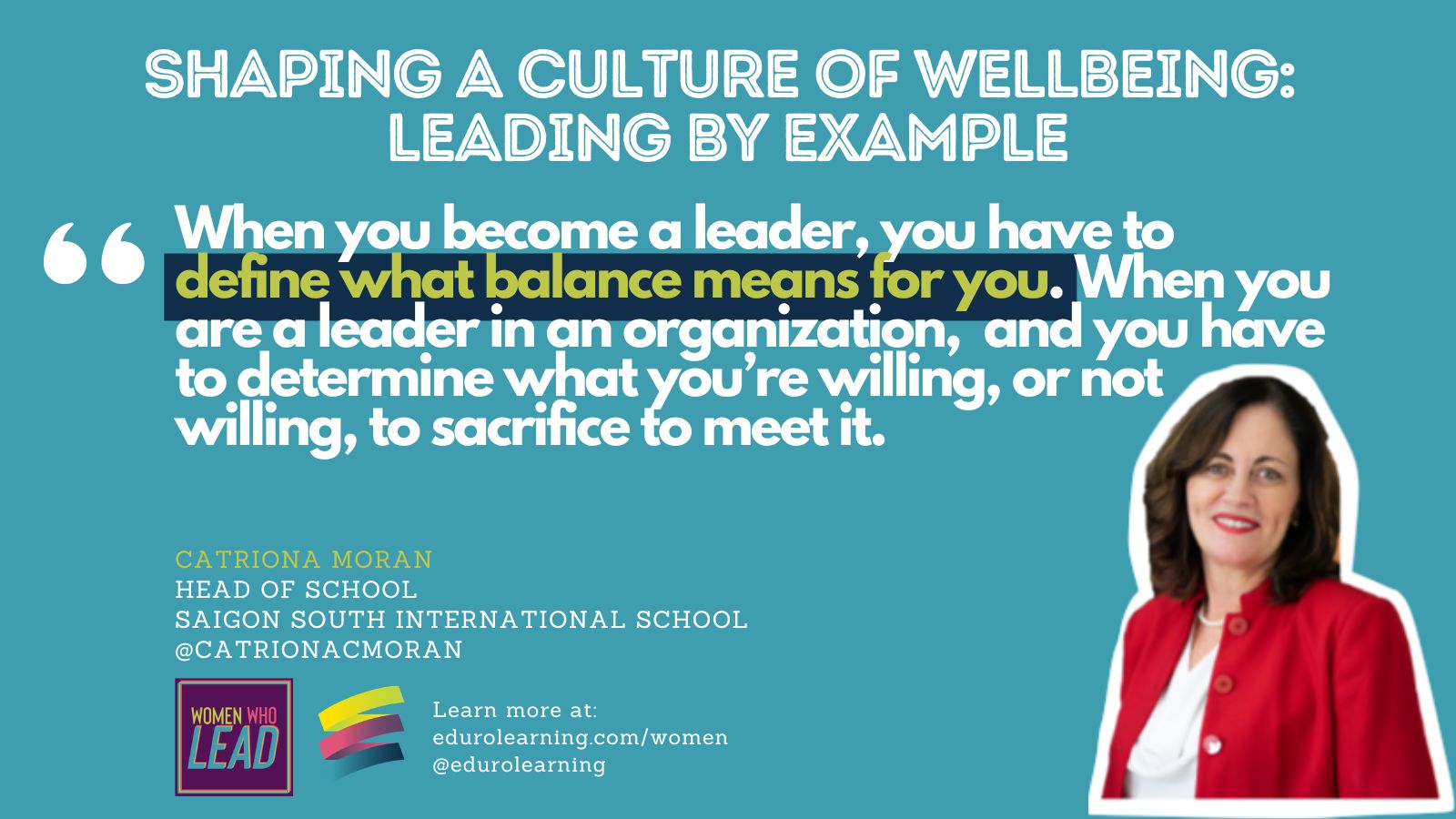
We know how hard it is to find a space of wellbeing for ourselves as individuals. My last article focused on ways that our Women Who Lead have built strategies to refresh, nourish and recharge independently. Today we’ll focus on the ways that they are intentional in designing their day, their communication, and their work routines to ensure that there is time for, and clarity around, the ways that they find a sense of balance.
As leaders, not only do we have the challenge of managing time and priorities to find space for wellbeing, in a position that never truly stops, but you also have the responsibility to model strategies for wellbeing for others. The strategies shared in today’s article may be helpful not only for you, as an individual leader, but to also pass on and discuss in your organization with others. Everyone in your organization deserves to find space for wellbeing. Sharing and encouraging the practices in today’s article may help others uncover new approaches as well.
You’ll notice that each of these is designed with the individual in mind, but if you take these practices and scale them up to an organizational level, so that each member has the opportunity to prioritize, set routines and boundaries and be intentional with their time, you’ll be working towards creating an organization that put wellness at the center, instead of an expectation that “just happens” outside of work.
Be a Role Model for Others
Dr. Chaunté Garrett, Superintendent of a K12 charter campus in North Carolina, USA, recognizes the importance of being a role model in the area of getting rest. If others can see her stop and rest and enjoy something, those opportunities also give them permission. During the pandemic she realized she needed to be able to communicate to others that she went for a walk today, or went out for brunch. Being able to communicate self care gives others permission to engage in similar practices that support their wellbeing.
Sheena Nabholz, Head of School and Lincoln Community School in Ghana, has learned how to be kinder to herself, build tools to manage stress, and mentally disengage from work, after a recent heart incident largely due to stress. In going through this process, she found that her colleagues also needed her to state her boundaries and priorities, to make it ok for them to put themselves first.
Be Intentional
Dr. Mary Ashun, Principal of Ghana International School, Accra, notes that making time for well being must be intentional. When she started as a school leader, she had no balance and she really struggled. Once she became intentional and set a timetable and communicated her timetable she was able to plan for self care and creativity. Dr. Ashun is a writer (she’s written 13 books, 4 plays and lyrics for music), and every year she sets a goal to do something she’s never done – on her next birthday she’s climbing a mountain. She now plans for creativity time every week and makes it part of her routine.
Nathalie Henderson, Chief Schools Officer at Indiana Public Schools, firmly believes in “me time”. She recognizes that she needs frequent breaks and she knows herself well enough to take them when she needs them. She finds energy in her other passions, having started two separate businesses (travel and leadership consulting). As with many of our Women Who Lead, Nathalie says “it’s not work to me because I enjoy it.” She recommends that leaders shouldn’t “shy away from help, take your “me” time, and don’t do things you don’t want to do because society says that you should do it.”
Uncover YOUR Leadership Potentential
Uncover your leadership potential with our new FREE leadership inventory.
This interactive resource highlights the 15 essential skills for emerging leaders that our Women Who Lead referenced in the interviews.
You’ll get a consolidated look at the leadership skills that are essential for leaders today – and the opportunity to reflect on how you’re doing, including your unique strengths and where you have room to grow!
Access the Leadership Inventory here!
Prioritize
Bridget McNamer, Chief Navigation Officer for Sidecar Counsel, views productivity in 2 ways. From one perspective, you need to prioritize because it’s simply not possible to be all things to all people. From the second perspective, she recommends you “promote yourself to key stakeholder”. You need to think about yourself objectively, keep yourself in mind as your planning. “If you don’t have a fuel tank that’s full on your end, you’re not going to be able to deliver for others.”
Lola Aneke, CEO of Cadet Academy in Nigeria, reminds herself that her productivity doesn’t define her. Even if she doesn’t finish what she expects, it’s ok. To find this space of mental wellbeing about productivity, she believes in the power of your thoughts and mind. Lola says: “When you send negative energy or emotions, your body tells you can’t. When you tell yourself to take it easy, you can manage it.” She recognizes that there are days when she’s just not going to be as productive and she uses self-talk to remind herself that she will catch up the next day. “A legacy is what you’re trying to build, empower others so it can live on after you.”
Set Boundaries
Katrina Charles, IB Diploma Coordinator at the American School of Doha, has recognized the importance of setting boundaries. She says: “As leaders we need to be very aware of what we do to set boundaries, so we model those boundaries. We set the tone for how we work. If the leader works around the clock, it sets the tone for everyone else.” Once you set boundaries, others will respect them.
She highlights that “setting boundaries based on priorities is a difficult thing when everything appears to be a priority.” The first step is to develop a relationship with your line manager to be very clear about exactly what needs to be done first so you can prioritize. Ultimately, you need to know what your limits are so that you can say no when needed.
Suzanna Jemsby, Head of School at Washington International School in the US, sets very clear boundaries between work and home. Even in a high-stakes school in a high-stakes city, she has committed to herself that she will not burn out. She sets clear boundaries and communicates them to the team, and then is disciplined about holding to them. Suzanna says: “Surround yourself with excellence and you can do anything.” She notes the importance of not taking the emotional burden for the school onto yourself, personally.
Set Routines
Beth Dressler, Elementary Principal and Deputy Head of School at Dresden International School in Germany set specific routines and priorities to find a space for mental wellbeing. In terms of family, she intentionally blocks out family time. At school, she blocks time in her calendar to be visible by visiting classrooms. For herself, she blocks time to exercise. The combination of all of these routines allows her to find a groove for most of the year. At times of the year, it will be a sprint, and things might get out of whack but, she explains, you can find your groove again when you shift back down into marathon mode.
Over the years, Carlene Hamley, Director of School Development at International School Services, has learned that she needs exercise and sport to find a sense of balance. She needs to find that gap in the day where she can “get the endorphins going” and have quiet time in her brain so she can process. This time for physical movement also provides space for mental wellbeing. She also finds that having a goal helps her stay focused and purposeful in all the decisions that she makes.
Creating a Culture of Wellbeing
Although the goals of the organization are always going to set priorities for all members of staff, by thinking intentionally and critically about the importance of wellness, and the practices that can help empower others to seek a space of health and balance, we can begin to build a culture of wellbeing. Being a role model in your leadership position, valuing the effort it can take to set priorities and respect boundaries is a powerful first step in shifting the importance away from work at all costs, to enabling everyone to bring their best self to work.
If you are looking for more real-life practical stories, examples and strategies like this, that uncover the realities of being a woman in leadership in education, you will love Women Who Lead. Designed to share the “behind the scenes” stories of over 70 successful women in leadership, this online course will help you find your leadership potential – and learn how to make it a reality. Our next global cohort begins in June, registration opens in May. Find out more here: https://edurolearning.com/women/.
Join the Cohort!
Hear more from our successful women leaders and learn the exact strategies they use to find a space of wellbeing! Learn from the stories of over 70 successful women leaders and build your professional learning network inside Women Who Lead!
Find out more at: https://edurolearning.com/women/.



0 responses on "Shaping a Culture of Wellbeing in Schools: Leading By Example"